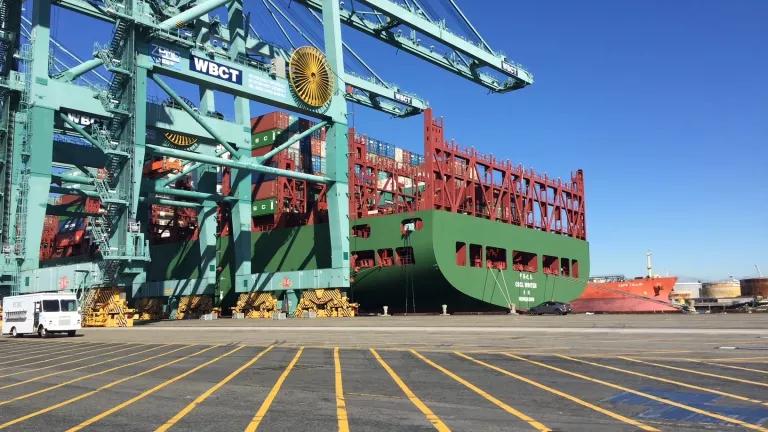Court Finds Port of L.A. in Violation of California Environmental Law
A judge has decided that the port put the profits of its tenant, China Shipping, above of the health of harbor workers and local residents.

Cargo ship using electric power while docking at the China Shipping terminal, as required by the 2008 EIR and the settlement between the Port and community and environmental groups
As the Los Angeles Times recently noted: “Port pollution is choking Southern California.” The ships, trucks, and equipment that carry cargo through the Port of Los Angeles produce huge amounts of deadly pollution every day, making the Port one of the largest sources of smog and soot in Southern California.
The Port of Los Angeles has acknowledged that port-related air pollution is making people sick. And it claims to be taking steps to reduce pollution and prioritize the health and lives of nearby communities. But, in reality, the Port’s public commitments are just smoke and mirrors. For decades, the Port has been waiving and ignoring pollution-cutting mitigation measures required by California law—making clear that the Port is prioritizing profits, not people.
This week, a court ruled that the City of Los Angeles, which owns the Port of Los Angeles, violated the California Environmental Quality Act (CEQA) when it tried to weaken environmental protections at one of the Port’s biggest terminals, leased by China Ocean Shipping Company. As the court explained, the evidence in the case exposed “the Port's repeated failures over many years to adopt a negotiating position with China Shipping which places compliance with California environmental law and the health of harbor workers and residents ahead of (or at least on equal footing with) its desire to appease its largest tenant.”
“This is another in long line of court rulings finding the port has violated laws designed to protect public health and the environment,” said Joe Lyou of Coalition for Clean Air—one of the plaintiffs in the lawsuit. “It says a lot about their continual prioritization of money over the health of their neighbors. It’s time for the city and port to make the systemic changes necessary to start making the health and welfare of the residents of Wilmington and San Pedro a higher priority than maximizing profits.”
The court’s decision is the latest win in a decades-long battle between the Port and environmental advocates fighting for the community’s right to breathe clean air—a battle that my colleague laid out in detail previously here.
After community groups and environmental advocates filed a similar lawsuit back in 2001, the Court of Appeal found that the Port violated CEQA when it decided to build the China Shipping terminal without any environmental review whatsoever. As a result of that landmark ruling, the Port agreed to a settlement that required it to pay $50 million for mitigation, as well as prepare the Environmental Impact Report (EIR) it should have done to begin with. In 2008, after heavy community input, the Port finally completed that EIR, in which the Port committed to additional pollution-cutting mitigation measures.
But soon thereafter, the Port began granting illegal secret waivers of mitigation measures behind closed doors, at China Shipping’s behest. When we found out what the Port was up to, our coalition of community groups and environmental advocates—including NRDC, San Pedro and Peninsula Homeowners Coalition, San Pedro Peninsula Homeowners United, East Yard Communities for Environmental Justice, and Coalition for Clean Air—sued the Port . . . again.
In this new lawsuit we asked the court to force the Port to do the things it had previously committed to, such as requiring polluting diesel cargo ships to plug into electric shoreside power and replacing trucks, cranes, tractors, and other equipment with zero-emission versions as soon as possible.
And sure enough, this week, 21 years after the first China Shipping lawsuit, the court found that the Port had again violated CEQA in several ways. The court found that the Port illegally discarded certain pollution-slashing measures, such as requiring nearly all cargo ships to plug into shoreside power and testing new state-of-the-art electric yard tractors. The court also found that the Port’s rosy analysis of the emissions from the terminal was essentially pie-in-the-sky: Contrary to the Port’s assessment, pollution from the terminal will continue to sicken local residents at significant rates unless drastic changes are made.
The court chastised the Port for failing to ensure the mitigation measures it adopts are binding against China Shipping, rather than just more promises that can continue to be broken. The court described the Port’s environmental commitments as nothing more than “a mere expression of hope, untethered to any realistic expectation that China Shipping will sublimate its desire for profitable port operations to the requirements of California law and the well-being of port workers and nearby residents.”
Local communities have long demanded that the Port and China Shipping take action that will protect nearby residents from air pollution instead of just protecting their profits.
“The Port has a 20-year record of flouting the law with this project, including issuing secret and illegal waivers of environmental protections to China Shipping. This took place at the highest levels of the Port, perhaps higher” said Peter Warren of San Pedro and Peninsula Homeowners Coalition. “The Port has shown that it cannot be trusted to follow CEQA, or to report honestly and transparently on mitigation compliance without independent oversight. This court victory is one step along the pathway to justice and accountability. As the court notes, the port allows and China shipping places priority on its profits ahead of compliance with California environmental law and the health of harbor workers and residents. This must stop.’”


.jpg.jpg?h=44b879e5&itok=Mrg2EnX5)